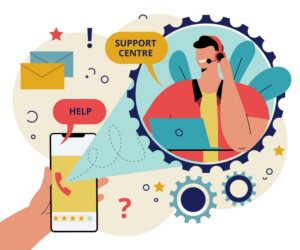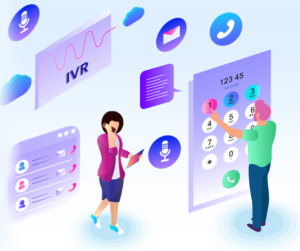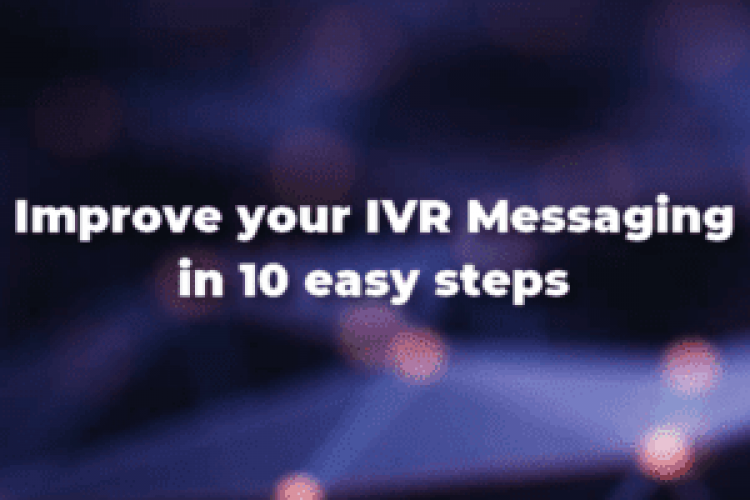An IVR, or Interactive Voice Response, is a system that interacts with inbound and outbound calls for a business by using voice prompts or text-to-speech with various pre-recorded alternatives. The caller can select the best option for him by using the telephone keypad or by speaking. In broader terms, customers can interact with their favorite brands using this technology.
In this article, we’ll take a look at Interactive Voice Response messaging and what it is. And we will also discuss 10 tactics to improve Customer Experience through IVR messaging.
Why does IVR messaging enhance customer experience?
 Contact Center Customer Experience always starts with how a customer feels before knowing how a particular technology works. And the premise of how customers feel when they call your contact center starts from your IVR messaging.
Contact Center Customer Experience always starts with how a customer feels before knowing how a particular technology works. And the premise of how customers feel when they call your contact center starts from your IVR messaging.
The first impression always lasts! So, when you design your Interactive Voice Response, you have to think very carefully about how your customers will feel and how easy you can make their experience in your IVR.
It’s easier for your agents to do their jobs when they can be on an IVR that’s been well thought out as they get better-qualified calls and spend less time on unnecessary conversations.
What is IVR messaging?
The IVR messaging is what customers hear when they call your contact center. It is a pre-recorded greeting and instructions that guide clients through the IVR menu system and connects them to an available agent.
Additionally, it is intended to inform the customer about corporate closures, business hours, and agent absences. Furthermore, the IVR message should be written in such a way that it directs agents to the voicemail box or to any other action steps necessary for question resolution.
Benefits of IVR Messaging for contact centers?
An Interactive Voice Response (IVR) broadcasts menus that the consumer may traverse using his audio or the telephone’s keypad, thanks to pre-recorded voice messages. The advantages of this messaging may be summarized in 3 points:
- Availability: Because it is available at all times, your clients will be able to receive information at any time of day or week by dialing only one number, regardless of the service they wish to reach. However, an IVR must be updated regularly to reflect client wants or corporate news.
- Organization: Each customer may be automatically sent to the most qualified agent to answer their problems. You can then give skill sets to your agents and ensure that they answer calls with as much valuable information as possible. Furthermore, you can maintain track of the cause for the exchanges so that you can easily spot reoccurring difficulties and enhance your service.
- Time savings: Redirecting calls as quickly as feasible and without human interaction saves a significant amount of time. The time and effort put into developing your IVR will immediately pay off. In addition, call redirection reduces the amount of time your agents spend on the phone and, as a result, your clients’ wait time. Quality communications save time not just for your organization but also for your consumers!
The Key Role of IVR messaging in contact centers
 When calling a company, a client expects to hear their voice and answer their questions. With businesses balancing home and office work, it’s more crucial than ever to ensure that consumers receive speedy and effective service from when they pick up the phone.
When calling a company, a client expects to hear their voice and answer their questions. With businesses balancing home and office work, it’s more crucial than ever to ensure that consumers receive speedy and effective service from when they pick up the phone.
Now that workforces of contact centers are split between offices and remote work. Routing calls to specific individuals and guaranteeing a smooth service can be easily disastrous. Businesses can ensure that their consumers spend the least amount of time on the phone and leave with a resolved problem and, perhaps, a grin on their face by implementing a straightforward, hassle-free IVR messaging.
How to improve your IVR messaging in 10 easy steps?
1. Polish your IVR greeting message
As we said previously, the first impression is the most important. That is why it is paramount not to forget the welcome message of your Interactive Voice Response (IVR). An introduction should not be too long and should be written in language that fits the image you want to project to your company.
Keep your voice natural and friendly while still being professional if you record the greeting message for your company’s IVR on your own; careful: Do not speak in an angry or monotone way. You can even tell if someone is smiling just by hearing their voice!
There are a lot of benefits to having a welcoming message that is said positively. It helps build trust and sends the message that the company is ready to help and build a positive relationship with callers.
The most simple and effective message is ” Hello and Welcome to X Company. Thanks for calling us.”
Most IVR greetings start with a welcome message that says who the company is. Unfortunately, while this is a great way to show off your business, they can also annoy and push away people.
While this might like a no-brainer, surprisingly, most companies don’t say anything about their business for more during the first 8 seconds of their welcome message.
2. Do not exceed 5 options in your IVR system
Remember that the customer wants to get a short and relevant answer. When your customers try to call you, they should only choose from a few different options on your IVR that give them the most important information.
Including promotional offers, event communication, or information about your social networks may not be the best way to go about it, though. However, when your callers are on hold, this information could be mixed in with music, making it hard for them to hear. So if you want to make things easier for people who call, you should give them clear and simple choices that they can choose without wasting time.
It’s best to keep the number of options on each menu to five or less. Besides that, your callers might get lost, which usually leads to them giving up. When people call, they want to know quickly where they are going. Before giving the extension number, it is better to provide the service or option that goes with it.
For example: “For Customer Service, Press 1”, not “Press 1 for Customer Service.”
3. Reporting is essential for managing your IVR system
To improve your IVR over time and tailor your contact center services to customers’ issues, it is critical to examine your call flows and callers’ behavior.
The ideal IVR should give reporting that is tailored to this optimization technique. You must assess the relevancy of the options presented and the efficacy of the communications and services given. For instance, if you discover that choice 2 concerns the majority of callers on your main menu, you may decide to relocate it as option 1 to improve your clients’ experience. Similarly, if the “access an adviser” option is excessively requested, it may indicate that your IVR menu needs improvement.
On a more operational level, IVR reporting can assist you in improving customer service management. For example, you may better modify your resources by talent or by a types of complaints based on the priority concerns raised via your IVR menu.
4. The IVR must be available at all times
The main menu should be accessible 24 hours, 7 days a week. Simple questions like company hours, office locations, account balances, and shipment information may be readily answered with precise responses, even when the contact center is closed.
However, the caller should be warned via tailored messages that they will not receive attention from any agent outside of work hours. In an ideal world, the caller should be offered to leave a voice message to be contacted later.
5. Beware of your deflection message
Deflection messages can be tricky to write. When you think about any given situation related to your customers, think about how you act. Many customers will not like hearing a deflection message in this case.
For example, most customers don’t track their deliveries online, so they ask for a refund. Because some people don’t know this is possible, they’ll be happy to go to the site instead. However, in this day and age, most people go to the website first when they want to find a digital answer. So a deflectioon message about a detour to the website once more, can be a pain.
 The ability to identify when an event occurs and assist an agent in handling the call correctly and providing the right information to the clients is reffered to as real-time monitoring. But the debate is still out in trying to determine if this should remove post-call analytics. Discover more about The Future of Post-Call Analysis in Contact Centers from our first contact podcast series.
The ability to identify when an event occurs and assist an agent in handling the call correctly and providing the right information to the clients is reffered to as real-time monitoring. But the debate is still out in trying to determine if this should remove post-call analytics. Discover more about The Future of Post-Call Analysis in Contact Centers from our first contact podcast series.
6. Testing and Remodeling
Following the initial setting of your contact center’s IVR, it is worthwhile to do a test under real-world situations. What is the purpose of this test? to assess the usefulness of your options as well as the efficacy of the communications and services provided.
First, note all the regular phone and e-mail inquiries during your campaign. Understand why your callers contact you and their most pressing concerns and then alter the IVR structure to prioritize the most often picked options.
The IVR can then handle the most basic inquiries. An agent can resolve all other issues, who can be reached by clicking a specific button.
That is why, it is always critical to properly test your Interactive Voice Response by observing how consumers interact with the solution. The test findings will assist you in identifying the aspects that harm your consumers’ experience.
During the first few weeks after your IVR is deployed, you may change the options available, the settings, the messaging, and even the music. Therefore, it is critical to forecast workload, especially when dealing with an IVR with a complicated tree structure.
7. Update your clients on your multichannel
Customers being informed about a new alternative service could help the contact center’s channel-shift strategy. Many modern customers, after all, choose digital-first service.
However, there are ways to make the message above better. For example, smartphone users can switch to live chat with the press of a keypad using an omnichannel solution. This reduces consumer effort. Remember to remove this message from the IVR after a month or two, mainly if it contains the phrase “recently,” as it is no longer an update but “old hat.”
Also, keep in mind that customers may use a second device to contact you via chat at the same time while they look for the quickest answer.
According to a study, 62% of customers prefer to contact with businesses via email for customer support. 48% prefer to call, 42% like webchat, and 36% prefer “Contact Us” forms. ” There is a large overlap in the figures. In total, 89% of customers anticipate an omnichannel experience.
8. Acknowledgement is key for empathy
Nobody calls in until they have an issue in some particular industries. Take, for example, the healthcare sector, Callers will most likely enter the line in a tense or critical condition.
Acknowledging your customers’ problems demonstrates that your contact center is aware of the client’s concerns. It enables them to rationalize their feelings and shows that everyone is on the same page.
In lines where consumers are prone to unpredictable, negative moods, an acknowledgment-based on-hold message will reassure them that they are not alone. In that regard, empathy training plays a key role for agents.
 If you want a deep dive into empathy training for agents and why it is so important in terms of managing the call and the customer contact. Check out our podcast episode on “Call Center Empathy Training – How to Do It Right“. Bruce Belfiore, CEO and Senior Research Executive of Benchmark Portal, thinks it’s oftentimes overlooked and combined with proper coaching, it will significantly improve the communication outcome.
If you want a deep dive into empathy training for agents and why it is so important in terms of managing the call and the customer contact. Check out our podcast episode on “Call Center Empathy Training – How to Do It Right“. Bruce Belfiore, CEO and Senior Research Executive of Benchmark Portal, thinks it’s oftentimes overlooked and combined with proper coaching, it will significantly improve the communication outcome.
9. Customer feedback will mirror your contact center performance
When the caller’s request has been fulfilled and the call is approaching its conclusion, it is critical to finish the call in a kind manner. Before finishing the call, ensure that the request has been recorded and thank the caller: “Your suggestion has been taken into consideration. We appreciate your call.”
Finish by telling the caller that your service is available at all times and encouraging them to contact you if they have any additional questions or requests for information.
The next step is to submit a caller satisfaction survey to collect feedback on your voice response and enhance it over time.
Contact centers collect post-call feedback regularly. Customers are kept engaged while waiting with an on-hold message that asks them if they are willing to offer post-interaction feedback. Also, because agents are no longer compelled to solicit clients for comments, such a message might reduce important KPIs such as the average handling time (AHT). The feedback will provide you a much more realistic view of how well your contact center is performing.
10. Regularly monitor your IVR
Regularly check the proper functioning of your IVR and adapt it according to your company’s news, current promotional offers or exceptional openings and/or closings. Also, your callers’ requests may evolve and change. Therefore, think about integrating your IVR into your customer feedback channels!
You can then propose a satisfaction survey at the end of each call. This is a perfect solution to better evaluate the perception of the customer experience and the level of satisfaction of your callers following your exchanges.
So, be prepared to make changes to your IVR’s different options or settings, taking into account the answers and comments left by your callers following the satisfaction surveys.
How can NobelBiz help?
 With years of experience in the trenches of Contact Center Solutions. At NobelBiz, we designed a framework, process and methodology for deploying Contact Center technology that takes business to the next level, from Omnichannel solutions to Voice Services.
With years of experience in the trenches of Contact Center Solutions. At NobelBiz, we designed a framework, process and methodology for deploying Contact Center technology that takes business to the next level, from Omnichannel solutions to Voice Services.
Our CCaaS Solution NobelBiz OMNI+ along with our voice carrier network for contact centers typically come with a more advanced form of IVR solutions called Dynamic Business Router. A technology that sets up automatic replies for texts and social media platforms.
Your contact center will no longer be stuck battling unwieldy and obsolete software that forces you to switch between so many apps that you’re constantly having to run. We offer your contact center an all-in-One customer-centric and fully Cloud-based Contact Center Solution, providing a unique blend of high-quality telecom services and cutting edge omnichannel software.

Abdelmounim Benharouga has always had a strong passion for writing and digital marketing. He started as a Digital Content Writer part of marketing department then moved to being Customer Success Manager for the African Region within the Nobelbiz team.



